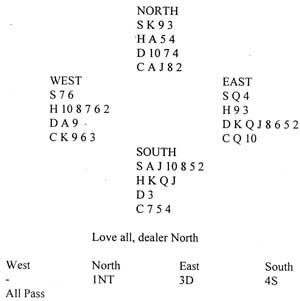|
Bridge
David Bird
 South
arrived in 4S and West opened the defence with ace and another diamond.
How would you have played this contract? Simon Cocheme, playing at
Londonís Young Chelsea Club, ruffed the second diamond. With a
combined holding of nine trumps it is normally recommended to play for
the drop. The odds are only 52:48 in favour of this play and once East
has shown long diamonds it becomes much better to finesse West for the
trump queen. Cocheme did this, losing unluckily to the doubleton queen.
He ruffed to diamond return, West showing out, and cashed three rounds
of hearts, watching to see how many hearts East had started with. When
East followed to only two hearts his shape was known to be 7-2-2-2.
Cocheme therefore played a club to the ace followed by another club.
East was end-played with the queen and had to concede a
ruff-and-discard. (West could not overtake the queen without setting up
dummyís jack of clubs. Nor could East have unblocked the queen under
the ace, or declarer would return to hand with a trump and lead towards
the club jack). If instead Eastís shape had turned out to be 2-3-7-1,
declarer would have led a club, covering Westís card (unless it was
the king or queen. If Eastís singleton club could beat the dummyís
card, he would again have to concede a ruff-and-discard. South
arrived in 4S and West opened the defence with ace and another diamond.
How would you have played this contract? Simon Cocheme, playing at
Londonís Young Chelsea Club, ruffed the second diamond. With a
combined holding of nine trumps it is normally recommended to play for
the drop. The odds are only 52:48 in favour of this play and once East
has shown long diamonds it becomes much better to finesse West for the
trump queen. Cocheme did this, losing unluckily to the doubleton queen.
He ruffed to diamond return, West showing out, and cashed three rounds
of hearts, watching to see how many hearts East had started with. When
East followed to only two hearts his shape was known to be 7-2-2-2.
Cocheme therefore played a club to the ace followed by another club.
East was end-played with the queen and had to concede a
ruff-and-discard. (West could not overtake the queen without setting up
dummyís jack of clubs. Nor could East have unblocked the queen under
the ace, or declarer would return to hand with a trump and lead towards
the club jack). If instead Eastís shape had turned out to be 2-3-7-1,
declarer would have led a club, covering Westís card (unless it was
the king or queen. If Eastís singleton club could beat the dummyís
card, he would again have to concede a ruff-and-discard.
 If you are playing a weak
(12-14 point) INT, what opening bid should you make? If you are playing a weak
(12-14 point) INT, what opening bid should you make?
Answer
Several writers have
recently recommended opening ID when you are 4-4 in the minors. I have
no idea why! If you open IC you give partner the opportunity to respond
ID and you can then find a fit in either minor. Open ID and it is harder
for partner to respond in clubs. Itís the same with hands of 4-1-4-4
shape (with a singleton heart). You do better to open IC rather than ID.
AWARDS: IC - 10, ID -
5.
ó (Knight Features)
|